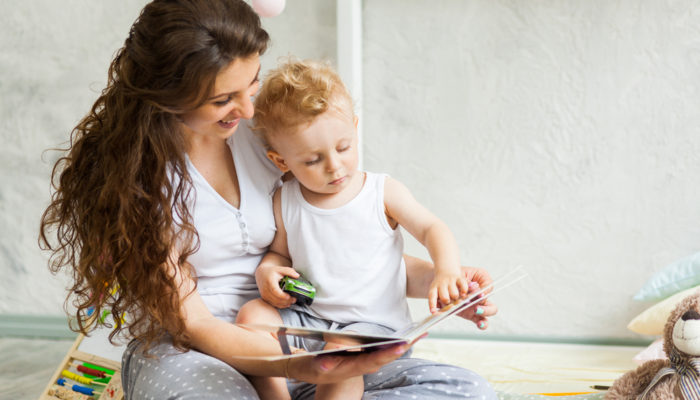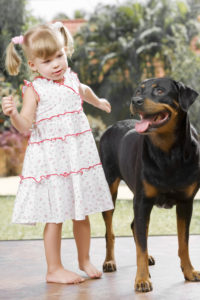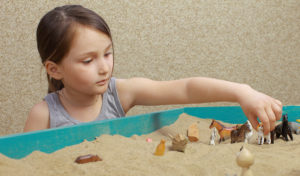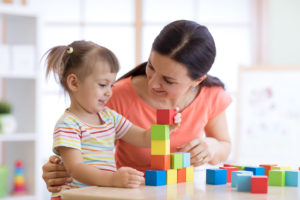
In this tools post I give you strategies to use with your child for the purpose of stimulating early vocabulary development. Most of your child’s early vocabulary will consist of naming words. These words help your child make sense of the physical environment and get ready to make basic requests. Being able to express needs by asking for basic things is an essential skill. It is also important to be able to share excitement about something such as a bird seen outside. But, remember that understanding the words comes long before your child is able to use them.
It is important for us to recognize that there is much more involved in learning vocabulary skills than simply labeling objects. The words we use to name individual objects do not reflect the full meaning of those words. In order to fully understand the meaning of a simple naming word, the child needs to hear it in association with a variety of similar, yet different objects.
To your baby, the word “cup” might simply mean the very cup your baby drinks out of each day. It takes more experiences with different cups for your child to generalize the meaning of the word. See my article on Learning Words.
Labeling–the First Step in Building Early Vocabulary
Your child’s vocabulary development starts long before he or she can say the words. It is therefore important that your little baby hears clearly spoken words in natural contexts from the start.
Baby “Conversations.” Start by labeling objects before your baby is even starting to talk. Name basic body parts such as foot, hand, tummy, nose etc. You might touch your baby’s nose and say, “Baby’s nose!” Then touch your own and say, “Mommy’s (Daddy’s) nose!” Use short phrases with emphasis on the key word. Then rephrase, giving yourself the opportunity to use the same key word several times in a natural way.

ToolsAs you put clothes on your baby, say things like, “Here is your shirt. Let’s put on your shirt!” Do the same with socks, shoes, pants etc. “Let’s put on your socks. Now we need your shoes. First your socks, then your shoes.” Don’t expect your baby to try to say the words. That will come naturally when your little one is ready. In the meantime, you are merely exposing your baby to a variety of naming words in a natural context. By and by this will build your child’s early vocabulary.
By these “conversations” you are also starting to help your child recognize associations between related objects and between actions and objects. Understanding associations between word meanings is an essential part of acquiring vocabulary skills.
“Pointing” Books.The little simple books with a single object on each page provide a great way to work on basic labeling. You point to the picture and name the object. Here it is best to initially say the word by itself and not attempt to embed it in a phrase. You want your child to learn the names of the objects. Do not coax your child to try to say the word with you. Again, that will come naturally when your child is ready.

This is likely to be your baby’s first exposure to two-dimensional pictures on a page representing real life objects. For this reason, it is best to choose books with reasonably realistic pictures of familiar objects. Some pictures are too cartoon-like for the child to relate them clearly to what they see in their environment. Unfortunately, many authors of books for the very young also try too hard to make the books “cute” by adding irrelevant details. That is unnecessary and can be distracting.
Another problem I see with these kinds of “Baby’s First Book” is the attempts to make them “educational” to the point of making them into ABC books or counting books. Such books certainly have their place but just not at this early stage. Remember that you are merely teaching your baby basic naming words to build early vocabulary skills.
Responding to Labeling Requests. At some point, your toddler will start to ask for words by pointing and saying, “Dat?” Your little one is now actively trying to learn the names of familiar things. You should first respond by simply saying the name of whatever your child is pointing to. You might be asked the name for the same item again and again. Resist the temptation to say, “I just told you!” Your child will need to hear the word many times before remembering it well enough to start using it.
Labeling with Expansion
Once you have clearly labeled an object, you can add a simple description to it. If your child points to a truck, you might say, “Truck. That’s a truck, a big truck.” We call this labeling with expansion. You are not merely embedding the label in a short, natural phrase. You are adding a new key word. Some basic describing words are also a normal part of a child’s early vocabulary.
When your child spontaneously names an object, acknowledge that you have understood and then add one thing. We can call this the accept-and-expand technique.

Your child points to a dog and says something that sounds like “dod” or even just “do’.” You might say, “Yes, a dog. Nice dog.” Your accepting the word and then immediately repeating it back with clear articulation gives your child validation while also providing a model. Do not ask your child to repeat the word again. This might intimidate your little one and make him or her less likely to continue naming things spontaneously.
Information Talk
Many years ago, when I was first exploring the field of speech pathology, I spent time observing in a speech clinic. Once a week, a teacher/therapist worked with a group of young preschoolers. She had the children standing around a sand box table in which she had placed a toy farm. While the children played, she just kept talking the whole time about what they were doing.

As I watched, my immediate impression was, “She is not giving those children a chance to talk!” What I did not realize at first was that these children were all at that time largely non-verbal. This teacher was using a technique that we have since come to call information talk.
This technique can be described as talking for the child before your child is able to put thoughts into words. You are providing words for whatever your child is involved in. This can be effectively used with normal toddlers well as preschoolers with significant delays. In short simple sentences, talk about the things you and your child are doing, and emphasize the key words. On a very simple level, what I called “baby conversations” could be considered an example of this technique.
Now that your baby has grown into a toddler, you have many more things to talk about. Perhaps you are having your baby sit on the counter and watch while you make a sandwich. You might then say, “We need some bread. Here is the bread. We need two slices of bread. Now we need…” By repeating key words and adding new ones you are continuing the important processes of labeling and expanding. You are effectively stimulating your child’s early vocabulary development.

As you interact with your toddler’s play activities, provide words for what he or she is doing. “You are putting the block on top… another block on top… a tall tower… uh-oh, it fell down!” Note that you should avoid taking over the play by starting to tell your child what to do. Instead, try simply to be the play-by-play announcer, putting words to what he or she is doing.
The picture below can be used to illustrate another scenario in which you are playing cars with your child. Your play-by-play might go something like this: “You have the big truck. I just have the little car. You are pushing the truck. It is coming. Uh-oh, it will hit my car!” (As explained in Learning Words, a few basic pronouns are also part of the child’s early vocabulary.)

When your child starts naming some of the objects and imitating phrases you have used, it is time to back off a bit on your play-by-play. You now use the accept-and-expand technique I described under Labeling with Expansion. Wait briefly for your child to say something that will start the “conversation.” If nothing comes, you just go back to describing what is going on in the play. But, if your child starts out, your conversation might go something like this:
“Bi’ twut.”
“Yes, you have the big truck! What do I have?”
“Ta’.“
“Yes, I have a car. A little car.”
Be careful not to ask too many questions, and avoid yes/no questions altogether. Questions help move conversations along, but they can be intimidating to your child at this early stage. Try to limit your questions to ones your child can answer with a single word or two-word phrase. Also make sure the needed word or phrase is one your child has already used. That way you will know it is in your child’s vocabulary.
With these activities you are gradually expanding your child’s vocabulary. But, you are doing much more. You are modeling speech articulation without correcting your child’s speech. You are now also introducing the verbal give-and-take that we call conversation. And, you are modeling complete sentences, even though it will be quite some time before your child will start to independently construct sentences. That usually does not happen until the child is two years old.




